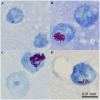Amoebae as potential environmental hosts for Mycobacterium ulcerans and other mycobacteria, but doubtful actors in Buruli ulcer epidemiology
- PMID: 22880141
- PMCID: PMC3413716
- DOI: 10.1371/journal.pntd.0001764
Amoebae as potential environmental hosts for Mycobacterium ulcerans and other mycobacteria, but doubtful actors in Buruli ulcer epidemiology
Abstract
Background: The reservoir and mode of transmission of Mycobacterium ulcerans, the causative agent of Buruli ulcer, remain unknown. Ecological, genetic and epidemiological information nonetheless suggests that M. ulcerans may reside in aquatic protozoa.
Methodology/principal findings: We experimentally infected Acanthamoeba polyphaga with M. ulcerans and found that the bacilli were phagocytised, not digested and remained viable for the duration of the experiment. Furthermore, we collected 13 water, 90 biofilm and 45 detritus samples in both Buruli ulcer endemic and non-endemic communities in Ghana, from which we cultivated amoeboid protozoa and mycobacteria. M. ulcerans was not isolated, but other mycobacteria were as frequently isolated from intracellular as from extracellular sources, suggesting that they commonly infect amoebae in nature. We screened the samples as well as the amoeba cultures for the M. ulcerans markers IS2404, IS2606 and KR-B. IS2404 was detected in 2% of the environmental samples and in 4% of the amoeba cultures. The IS2404 positive amoeba cultures included up to 5 different protozoan species, and originated both from Buruli ulcer endemic and non-endemic communities.
Conclusions/significance: This is the first report of experimental infection of amoebae with M. ulcerans and of the detection of the marker IS2404 in amoeba cultures isolated from the environment. We conclude that amoeba are potential natural hosts for M. ulcerans, yet remain sceptical about their implication in the transmission of M. ulcerans to humans and their importance in the epidemiology of Buruli ulcer.
Conflict of interest statement
The authors have declared that no competing interests exist.
Figures




References
-
- Falkinham JO (2002) Nontuberculous mycobacteria in the environment. Clin Chest Med 23: 529–551. - PubMed
-
- WHO World Health Organization “Buruli ulcer: Number of new cases of Buruli ulcer reported (per year). Available: http://apps.who.int/neglected_diseases/ntddata/buruli/buruli.html. Accessed 2012 Jul 15..
Publication types
MeSH terms
Substances
Associated data
- Actions
- Actions
- Actions
- Actions
- Actions
- Actions
- Actions
- Actions
- Actions
- Actions
- Actions
- Actions
- Actions
- Actions
LinkOut - more resources
Full Text Sources
Molecular Biology Databases

